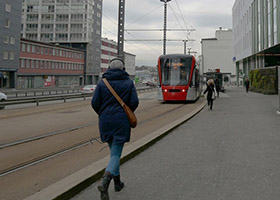Workplaces and dwellings located in nodes generates less car traffic per inhabitant and per employee than dwellings and workplaces located outside the nodes, but more traffic than those located in city centres.
A Norwegian research project has studied the effects on traffic and emissions of densification in nodes in three of the largest cities in Norway; Bergen, Kristiansand and Oslo.
“We found that workplaces and dwellings located in nodes generates less car traffic per inhabitant and per employee than dwellings and workplaces located outside the nodes, city centre or the inner city”, chief research officer Aud Tennøy at Institute of Transport Economics says.

The densification of public transport nodes is defined as an important step in strategies to reach the government’s goal of zero growth in private car traffic in Norwegian cities.
Photo: Oddrun Helen Hagen
However, the traffic reducing effects were significantly higher for the city centre than for the nodes.
“That means that cities that wish to minimise the amount of car traffic and emissions should locate new dwellings and workplaces in and in immediate proximity to the city centre, before considering the nodes outside the city centre”, Tennøy continue.
To increase the traffic reducing effects of locating dwellings and workplaces in nodes, the main approach should be to reduce private car accessibility to better accommodate bicycling as well as make the nodes more walkable and urban.
The densification of public transport nodes is defined as an important step in strategies to reach the government’s goal of zero growth in private car traffic in Norwegian cities. This is based on an understanding that dense development close to high standard public transit gives more inhabitants, employees and visitors the possibility to choose public transport, but also walking and bicycling for travelling to and from the area.
Thus, dwellings and workplaces generate less car traffic per inhabitant and per employee. Further, that co-location of dwellings and local retail, service and the like, in nodes, contributes to the inhabitants walking, bicycling or shorter car travel for these kinds of trips. There is, however, few Norwegian studies documenting if and to what extent localisation in nodes contributes in generating less car traffic, and how possible traffic reducing effects varies with functions, mixed use and other properties of the nodes. This project contributes to fill knowledge gaps on the effects of the nodal point strategy often chosen as an important part of the integrated land use and transport planning in Norwegian cities.
Report:
Effects on traffic and emissions of densification in nodes in Bergen, Kristiansand and Oslo.
TØI Report 1575/2017.
Authors: Aud Tennøy, Frants Gundersen, Oddrun Helen Hagen, Marianne Knapskog & Tanu Priya Uteng.
Link to English Report Summary https://www.toi.no/getfile.php/1346172/Publikasjoner/T%C3%98I%20rapporter/2017/1575-2017/1575-2017_summary.pdf
 Contact:
Contact:
Aud Tennøy
ate@toi.no
TØI, Norway






Follow us: